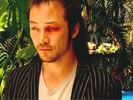Eye For Film >> Movies >> Invisible Waves (2006) Film Review
Invisible Waves is director Pen-Ek Ratanaruang's second collaboration with writer Prabda Yoon, cinematographer Chris Doyle (In The Mood For Love, Hero, Paranoid Park) and actor Tadanobu Asano (Ichi The Killer, Vital, Gojoe, Bright Future) - and like their earlier Last Life In The Universe (2003), it is an apparently simple tale of a Japanese man in exile and on the run. "Apparently simple", because like the delicate images from which it is composed (all desaturated wideshots or obliquely angled close-ups on anything but a face), the narrative of Invisible Waves is a series of suggestions and ellipses that viewers must complete and colour for themselves. Any description of the plot is necessarily provisional and tentative.
Guilt and death have been hanging over chef Kyoji (Asano) ever since he began an affair with Seiko (Tomono Kuga), the wife of his Hong Kong gangster boss Wiwat (Toon Hiranyasap). On Wiwat's orders, Kyoji first poisons Seiko, and then leaves his home in Macao for Phuket, where he is to lay low for a while.

During the boat crossing to Thailand, Kyoji finds himself both literally and metaphorically at sea, unsettled by a series of surreal encounters. A man named Hideki (Hiro Sano) insists on being an old schoolfriend even though Kyoji cannot recall ever having seen him before. A ship's bartender (Hideki Jitsuyama), who is the spitting image of Kyoji's own father, engages the chef in a bizarre conversation about sin and atonement. Even Kyoji's malfunctioning cabin rebels against its harried guest (1408 style). Only the presence of single mother Noi (Gang Hye-jung, of Oldboy and Lady Vengeance fame) and her baby daughter Nid bring any degree of comfort to the stressed-out fugitive.
In Phuket, settled into a hotel room as disordered as his ship's cabin, Kyoji is robbed, and quickly comes to suspect that Lizard (Ken Mitsuishi), his "only contact with the past", is more of a threat than a help. Double-crossed and left for dead, Kyoji returns to Macao and confronts Wiwat - before finally embracing his own fate.
On paper, Invisible Waves may sound like just another Asian action policier or revenge thriller, but in reality it is altogether more abstract and elusive than that - for the film displays only the most indirect interest in the presentation of violence, and if it is part moody noir, it is also part absurdist comedy, part redemptive psychodrama, part ghost story, part melancholic portrait of alienation (with three different islands as its settings, and a man from a fourth island state as its protagonist), and part metaphysical travelogue of the Stygian crossing from life to death.
As in Last Life In The Universe, it remains an open question whether Asano's character might already be dead from the outset of 'events' - an ambiguity that can be traced back to the unrestful protagonist of John Boorman's similarly vengeance-driven Point Blank (1967). This idea that Kyoji may be lost in a limbo where criminal and infernal underworlds meet is supported by the casting of Eric Tsang (from the Infernal Affairs trilogy) as a monk, and by allusions to Gozu (2003). Gozu was directed by Ratanaruang's old friend Takashi Miike (who cameos in Last Life In The Universe, as does a poster for his 2001 film Ichi The Killer) and, like Invisible Waves, features both a minor gangster ordered on an excursion to a nightmarish interzone, and the copious drinking of milk.
This view of Invisible Waves as a film set in a fluid space between life and death is underscored by its most prominent reference point, Stanley Kubrick's terrifying supernatural thriller The Shining (1980). The shifting location of Kyoji's conversation with the otherworldly bartender, beginning in an otherwise empty bar and ending in the attached bathroom, is clearly modelled on Jack's chilling chat with caretaker-turned-barman Grady; the winding streets of Macao, the different decks of the cruise liner, and the looping corridors of the Thai hotel are all made to blur into one hellish labyrinth, much like the hotel corridors and garden maze in Kubrick's film; and the graffito 'redrum' is conspicuously emblazoned on a picture in Kyoji's hotel room (and repeatedly shown in reverse in a mirror).
Still, Invisible Waves is just the merest ghost of a horror film, lacking any of that genre's more typically sensationalist elements or special effects, even if it is no less haunting for all its restraint. Over the years Asano has established himself as one of cinema's finest avatars of calm, and the stillness which he exudes here, abetted by Hualampong Riddim's vibey synth score, pervades the film with a subdued tranquility that is matched by Chris Doyle's sombre colour scheme. This melancholic understatement is what gives Invisibles Waves its poetry, suggestive of untold depths concealed beneath the rippling surface. These are waters well worth crossing more than once.
Reviewed on: 13 Nov 2007



















